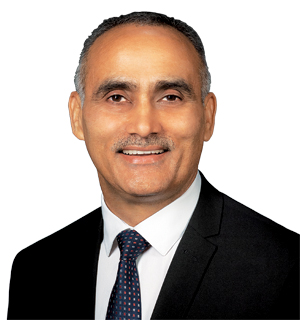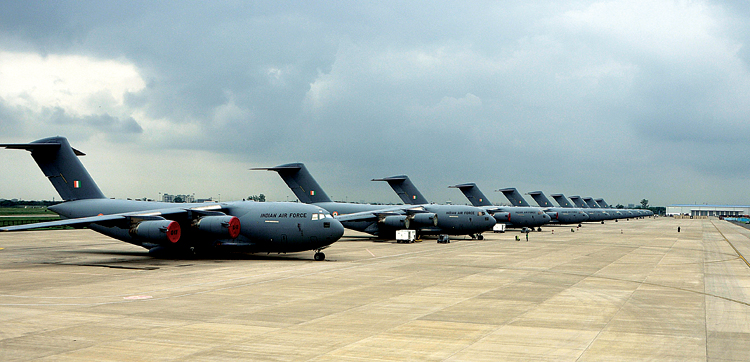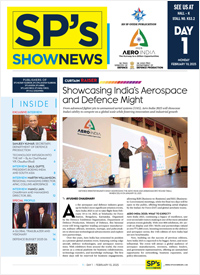- Prime Minister Narendra Modi inaugurates Aero India 2023 in Bengaluru; Releases Commemorative Stamp
- Defence Secretary meets delegations from Saudi Arabia, USA and Oman on the sidelines of Aero India 2023
- Foreign Ministers of 32 countries to attend Aero India 2023
- Embraer showcases the C-390 Millennium at Aero India 2023
INTERVIEW / BOEING
“Boeing believes in building indigenous capabilities towards driving innovation and contributing to the growth of the Indian A&D industry”
Surendra Ahuja, Managing Director, Boeing Defence India talks about Boeing’s presence in India, the upcoming opportunities and their support to the growth of an indigenous aerospace and defence ecosystem

SP's ShowNews (SP’s): What according to you are the future opportunities for Boeing in India especially inthe defence sector?
Surendra Ahuja (Ahuja): Boeing has been working with India’s defence forces for many years supporting their mission-readiness and modernisation objectives. Our portfolio of products and services offer unmatched operational capabilities across the entire mission spectrum.
In addition to our response to the Indian Air Force (IAF) RFI for the 114 MRFA and the Indian Navy’s (IN) MRCBF with the F/A-18 Block III Super Hornet, there are several other opportunities we are pursuing herein India. In 2020, the Ministry of Defence signed the contract for the acquisition of an additional six Apaches for the Indian Army. We’re also having discussions with IAF on their tanker requirements.
We are seeing the growth of our services business and with it, in the value Boeing is able to provide through the lifecycle support. We are working with the IAF and the IN to provide exceptional operational capability and readiness for the P-8Is, the C-17s, and the Head of State aircraft through sustainment contracts, and the Chinooks and Apaches through warranty.
The recent developments in India’s space arena that allow the private sector to participate in this sector are positive. We look forward to partnering with ISRO in their endeavours.We want to bring the best of Boeing to India and the best of India to Boeing…and to the world!
The defence MRO market segment in India is projected to reach an approximate figure of $2.5 billion by 2025? Do you propose to offer any solutions on this front?
Ahuja: Last year, the Ministry of Defence signed a contract for the acquisition of six additional Apaches for the Indian Army. Significant partsof these aircraft will be built at Tata Boeing Aerospace Limited (TBAL), our joint venture with Tata in Hyderabad. We’re also seeing growth in our localisation of MRO services and training, and the value Boeing is able to provide through the lifecycle of its products. We work with the Indian Air Force and the Indian Navy to provide exceptional operational capability and readiness to the P-8Is, C-17s, and Head of State aircraft through local sustainment services in India.

In so far as Boeing goes, the lessons we’ve picked from supporting C-17 and P-8I in India, coupled with in-depth Boeing experience in sustaining aircrafts worldwide, we’ve been able to set processes to develop similar sustainment concepts for other aircraft. For the aircraft, it means deploying the best global expertise gleaned from the experience of operating these aircraft in different conditions, and to suit different needs.
SP’s: Can you explain more about the kind of maintenance work Boeing is involved in for P-8I and C-17?
Ahuja: We are working with the IAF and IN to provide operational capability and readiness for the P-8Is, the C-17s, and the Head of State aircraft through sustainment contracts, and for the Chinook and Apache fleets through warranty support. Ensuring mission readiness of our customers and providing them seamless services and support on our platforms is an imperative for Boeing. Boeing’s local sustainment support footprint is enhancing responsiveness on sustainment and training contracts.
Boeing supports the IAF C-17 fleet under the Globemaster Integrated Support Program (GISP) that maintains high mission-capability rates, by providing them access to an extensive support network for parts availability and economies of scale.
India’s P-8I fleet is also supported through Boeing’s services business by providing spares, ground support equipment, and field service representative support. Boeing’s integrated logistics support has enabled the highest state of fleet readiness at the lowest possible costs. Since induction, the Indian Navy P-8I fleet has surpassed 29,000 flight hours. Boeing’s training and support package for the P-8I promises to increase proficiency in a shorter time, while reducing the onaircraft training time resulting in increased aircraft availability for mission tasking. A 60,000 sq. ft. Training Support and Data Handling Centre is being set up at INS Rajali, Arakkonam (the base for P-8I fleet), with a secondary centre at Naval Institute of Aeronautical Technology (NIAT), Kochi.
We are also working with Indian companies to develop capabilities in the country so that they can perform maintenance locally, including heavy checks and supply of indigenous equipment. Air Works in partnership with Boeing, successfully completed the first heavy maintenance check for the first P-8I in 2019. We plan to continue working with Air Works for similar checks on the remaining aircraft. Further capability development planning is in the works to support the growing P-8I fleet, improving the local aviation ecosystem while ensuring quicker turnaround for the Indian Navy.
SP’s: Can you also provide an update on Boeing India’s engineering presence and the growing relationship with its suppliers in India?
Ahuja: Boeing believes in building indigenous capabilities towards driving innovation and contributing to the growth of the Indian A&D industry. Teams in India undertake high-quality, advanced aerospace work spanning engineering design of structures and systems, manufacturing support, developing systems to test our aircraft, and providing digital solutions to our airline customers. Cutting-edge R&D in traditional and emerging areas such as next-generation airplane health management, environment-friendly coatings, advanced networks and securecommunication are areas where teams are leveraging new-age technologies to replace traditional approaches, enhancing safety and productivity.
Boeing engineering design teams are working with the R&D team to leverage Artificial Intelligence and Machine Learning methods to introduce automation in the process, resulting in a significant reduction in time taken for tasks, and also enhanced quality of output. Digital aviation efforts are helping airlines reduce fuel consumption through route optimisation, and make effective utilisation of their crew. Digital engineering is being used to enhance the manufacturing environment and provide value to customers. Digital threading is being used to create a digital twin before manufacturing aircraft systems, resulting in fewer manufacturing issues. This drives efficiency, optimizes product design, and enhances manufacturability, making the end-to-end supply chain more digital.
Boeing Research & Technology India has delivered commercially viable solutions for Airplane Health Management (AHM) and Air Traffic Management (ATM). Its ATM experts are currently working with the Airports Authority of India to develop a roadmap for air traffic management modernisation in the country. Today, the research center is using artificial intelligence and machine learning to improve the quality of wide-body airplanes that Boeing delivers. Using Internet-of-Things (IoT) technologies, its engineers are finding ways to improve passenger experience during air travel.
We continue to grow a globally competitive supplier base in India, with strong partnerships aligned with the Aatmanirbhar Bharat vision. Our sourcing from India stands at $1 billion per year from 225 suppliers who are manufacturing critical systems and components for some of Boeing’s most advanced products. Our joint venture with Tata, Tata Boeing Aerospace Limited (TBAL), in Hyderabad, is producing aero-structures for Boeing’s Apache helicopter, including fuselages, secondary structures and vertical spar boxes for Indian and global customers, employing over 500 engineers and technicians. Apache fuselages and structures made in this cutting-edge factory in Hyderabad are for not just the Indian Army but for customers around the world, including the US Army. We look forward to seeing the Indian Army’s recently contracted six new Apaches rolling down that production line. The state-of-the-art facility is an example of Boeing’s strategic focus on Make in India and TBAL marks a major step towards the co-development of integrated systems in aerospace and defence in India.
Dynamatic Technologies, another Indian partner, manufactures the ramp and complex aft pylon for Chinook heavy-lift helicopters. Rossell Techsys manufactures wire harness and electrical panel for the AH-64 Apache, and the harness for V-22 Osprey. SASMOS HET Technologies manufactures electrical panel assemblies and wire harness for the F/A-18 Super Hornet and F-15 Strike Eagle. Hindustan Aeronautics Ltd (HAL) manufactures F/A-18 gun bay doors and wire harnesses, and P-8I weapons bay doors and friend-or-foe identification transponders.
In terms of skilling and upskilling, we are developing Indian MSMEs, aircraft maintenance engineers, technicians, and frontline factory workers across India with our industry partners like Tata, Rossell, Jaivel and Lakshmi Machine Works. Our vision is a robust, globally competitive aerospace and defence ecosystem in India.





